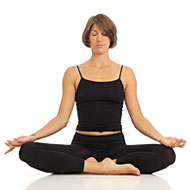- Aromatherapy (36)
- Benefits of Yoga (282)
- Home Remedies (1087)
- massage therapy (9)
- Preventive Therapy (135)
- Running (41)
- Skin Care (15)
- Stress Relief (25)
- Stretching (5)
- walking (33)
- Womens Health (14)
- Yoga Benefits for Pregnant Women (16)
- Yoga Benefits for Students (3)
- Yoga for Children (11)
- Yoga for Holistic Living (37)
- Yoga for Midlife Crisis (3)
- Yoga for Senior Citizens (2)
- Yoga for the Workplace (1)
- Yoga Health Tips (185)
- Yoga Practice during Menstruation (5)
How Is Pranayama, Pratyahara & Dharana Done In Yoga?

Yoga is a holistic science that deals with the body, mind, heart and spirit. The word Yoga itself is suggestive of this. It is derived from the Sanskrit root “Yujir Yoge” which means to join, to yoke, to put together.
The Eight-Fold Path In Yoga
- Yamas (Do’s)
- Niyamas (Don’ts)
- Asana (Yoga postures)
- Pranayama (Breathing exercises)
- Pratyahara (Withdrawal of the senses)
- Dharana (Concentration)
- Dhyana (Meditation) and
- Samadhi (A state of super consciousness)
What this entails is, bringing together all the disharmonious systems within oneself, starting with ones body. This leads to good physical health. This is mainly achieved through the practice of Asanas (yoga poses), Pranayama (a set of breathing exercises), Kriyas (cleansing techniques) and a Sattvic (pure and simple), predominantly vegetarian Yogic Diet.
Pranayama (breathing exercises) also help heal the body of many diseases and detoxifies the system. But Pranayama has a much larger function. It also works as a meditative process and prepares the mind for meditation. All Pranayama (breathing exercises) require that you do Kapalabhati (Skull Cleansing) before you begin.
The Pranayama are
- Anuloma-Viloma (Alternate Nostril Breathing)
- Ujjayi (Ocean Breath)
- Brahmari (Bee-buzzing Breath)
- Bhastrika (Bellows Breath)
- Sitali (Cooling Breath)
- Sitkari (again a Cooling Breathing Technique)
- Surya Bhedana (predominantly Right Nostril Breathing)
Please note that all these should be done under strict guidance and supervision of a trained, experienced Yoga teacher not only to achieve good results but to avoid injuries from erroneous practices.
Pratyahara
Ideally, the next stage is Pratyahara and is said to be practiced only after years of intense Tapas (austerity). But you can start right away. It involves control over one’s senses, mainly not giving in to sensory pleasures derived from the eyes, ears, nose, mouth (tongue – through taste and speech) and touch. Please note, Yoga doesn’t advocate absolute abstinence. It only suggests moderation in everything we do – think, speak and act – so that we don’t become enslaved by our senses as most of us sadly are, these days. The Yogic techniques prescribed for this are reading scriptures, Satsang (company of holy and learned men and women) and Yoni Mudra. This involves sitting in a meditative posture and shutting your ears, eyes, nose and mouth with your fingers.
Dharana
Dharana means nothing but concentration. We are all capable of this and the best way to achieve it is through the Yogic bhavas (attitudes). They are four in number: Dharma (duty), Jnana (knowledge), Vairagya (detachment) and Aishwarya). So when doing anything, simply ask yourself: “Am I doing my duty to the fullest? Am I doing it knowledgeably and with a view to getting more (Self) knowledge? Am I detached from the fruits of my action or am I always expecting results, praise, adulation, etc? And finally, am I self-reliant or independent in most of what I do.”
This takes time, but we can all do it. Millions, the world over are practicing with fantastic results. Your world will definitely be a better one, the sooner you start, the longer you practice, and the more perseverant you are.
- RSS Feeds -
- All posts
- All comments
- Spiritual Yoga Yoga is normally credited to two great, spiritual stalwarts: Lord Sri Krishna...
- Cancer Patients - Yoga Options The word Yoga comes from the Sanskrit root “Yujir Yogey”. It mean...
- How To Design A Yoga Practice How to design a Yoga practice depends a lot upon one’s Yoga practice. ...
- Different Types of Yoga Explained The history of yoga indicates that Yoga is an age old discipline that origina...